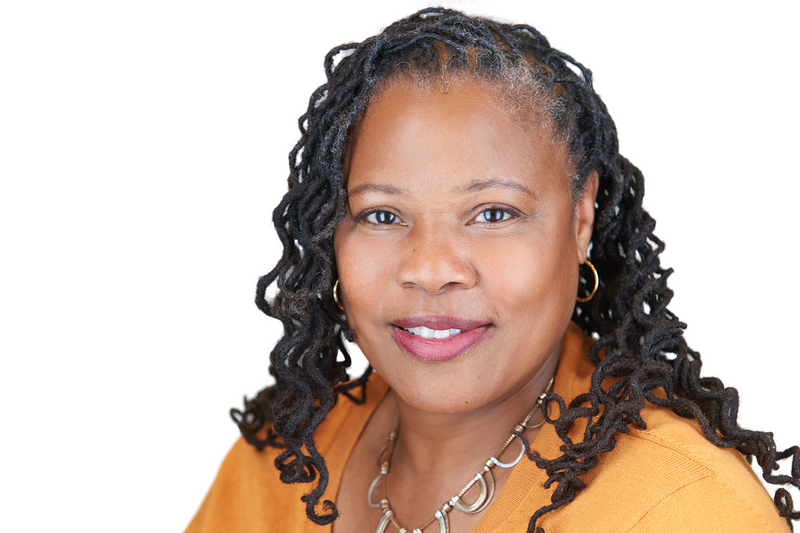December 6, 2021
•
5 min (est.)•
Vol. 79•
No. 4Zaretta Hammond on Equity and Student Engagement
To help students grow as learners, schools must resist the pedagogy of compliance.
Credit: Zaretta Hammond
Zaretta Hammond, a former teacher and college writing instructor, is an influential curriculum designer and trainer who works with school districts on issues of equity, literacy, and culturally responsive instruction. She is the author of Culturally Responsive Teaching and the Brain: Promoting Authentic Engagement and Rigor Among Culturally and Linguistically Diverse Students (Corwin, 2014), which positions culturally responsive teaching as a method for honing cognitive capacity in students and supporting independent learning and agency. She is currently working on a book on instructional equity.
Where do you see student engagement fitting into instructional equity?
For me, equity is about making sure every student is a powerful learner—that's the equity goal we should be shooting for. So, I don't see instructional equity merely in terms of system metrics like getting more kids into AP classes or advanced algebra. Because if we get more kids in advanced algebra, but they can't carry the cognitive load required for advanced algebra, that doesn't help anybody. When we think about equity as making sure every student reaches their intellectual capacity so they can carry a heavier cognitive load—so that they can take part in deep learning that is rigorous, for example—then we see how critical it is to create the kind of intellectual curiosity and engagement that allows us to kick-start students' information processing and meaning making. And I mean true intellectual engagement, not just having fun. Too often we reduce engagement to hands-on "activities" or to a lesson that's fun and interactive, but we don't necessarily connect that interactivity to academic rigor or cognitive capacity building. And that's the thing that's so important. For me, the question is: Do we do enough to create classroom environments for students to be intellectually curious? The problem is not typically with the kids, who always come in with intellectual curiosity on some level. It's with the environments we are creating.
What common mistakes do you see schools making in terms of student engagement, particularly with respect to students who may be struggling?
I think one of the biggest mistakes we make, particularly for struggling students, who are disproportionately children of color, is that we employ a pedagogy of compliance. I mean, if you look at what's being put in front of these students sometimes, it's kind of mind-numbing. There's no complexity to the work. It lacks any real-life context to address the typical student question of "What's the use of me learning this?" The learning is too decontextualized and compartmentalized. By contrast, you could use something like place-based learning, where students are trying to solve a local problem—for example, a water issue in the community, or a land-erosion pattern, or even a problem like too much garbage in the cafeteria. Take the example of the organization Agency by Design Oakland, which has a whole curriculum (in collaboration with the Culture of Repair Project and Maker Ed) around the concept of "repair" in the community. The questions they have students asking are real, complex, and interesting. Teachers create a compelling context for having students use the skills and information they are learning to build and preserve things of value.
Falling into a pedagogy of compliance that values orderliness over the messiness of complex work means we miss the opportunity to ignite engagement naturally. What we know from the science of learning is that when human beings try to figure something out, the brain is fired with intellectual curiosity. The brain loves a puzzle—that's the type of complexity that stimulates engagement.
Schools say they are doing different types of inquiry-based or project-based learning, but too often it's just a series of one-off activities for struggling students to do something "fun," but not cognitively interesting. Then, after the activity, we're back to compliance-focused pedagogy—meaning teachers do most of the talking and thinking, while students aren't creating anything or actively processing what they are hearing or reading. We need to be orchestrating curiosity. Why not start class with a provocative question or a puzzle related to the topic to ignite that intellectual curiosity? Instead, we squander the first 5 to 10 minutes of class with learning target review and a tepid "do-now."
Another mistake we make, again especially with struggling students, is over-scaffolding instruction. Remember, the curiosity we're trying to spark comes in the wondering, in the process of trying to figure something out, in the complexity of seeing connections between things that don't seem like they go together. But we edit out opportunities for this productive struggle and in the process make the content bland. We over-scaffold for our lower performers because we don't have enough trust in their ability to struggle productively without stressing out. So we micromanage their experiences. We scaffold out the curiosity and complexity, which is actually what ignites their brain.
Are there specific principles educators can glean from the science of learning—another long-time focus of yours—to set the conditions for greater intellectual curiosity and engagement?
I think number one is that we have to create a community of learners. We have a tendency to focus on relationships and community-building as purely social—you know, the culture of the classroom, kids getting along, that sort of thing. But what we don't do is create a set of studio habits for learning in community. Think about what artists do when they come together in a studio. They create a community of practice. They learn skills to develop their craft. They learn to critique and analyze each other's work. They extend and stretch themselves cognitively to get better through feedback provided by peers as critical friends. But in classrooms—again, especially in those with students who are low performers—we are afraid of critique or feedback that asks them to level up their skills or stretch themselves. Everything is very nicey-nice. We are afraid of damaging kids' self-esteem. But the reality is that students already know they are struggling, and that's what's damaging their self-esteem.
We have to instill community habits for growth in learning. Competence precedes confidence. When I'm a competent learner, I have the confidence to engage in intellectual endeavors that might stretch me, might confuse me, or might lead to productive struggle. That's precisely what the science of learning tells us makes the brain grow and allows us to carry a greater cognitive load. But if I'm just coasting and everybody's afraid of challenging me, I'm not getting anywhere cognitively, and I disengage. So now you have a pedagogy of compliance mixed with a culture of niceness. Sometimes they mask one another. Neither allows students to grow as learners.
You've talked of trying to marry the science of learning with culturally responsive teaching. Where do you see the need for convergence?
Actually, it's not a matter of convergence. They are just two sides of the same coin—that's what I want educators to see. We need to understand that the responsive part in culturally responsive teaching is the schema part of the zone of proximal development: It's this area of prior knowledge we can build on. I think educators get caught up in the culture part of culturally responsive teaching, and they mistake the whole thing for antiracist education or multiculturalism. That's not what culturally responsive teaching is. Culturally responsive teaching is about tapping the schema, or the funds of knowledge, that the student brings in; it's not just about trying to build self-esteem because his racial or linguistic identity is superficially represented in a text. As a teacher, I need to recognize, honor, and actually use students' funds of knowledge to make learning sticky. The science says learning for understanding happens when we integrate new knowledge with our existing knowledge. So, the more the teacher knows about a student's schema, the more she then can start to engage that student by making "cognitive hooks" between the learner's context, interests, cultural knowledge, and the new content in the curriculum. If the teacher wants to make material sticky, she contextualizes it—she uses metaphor and analogy. But if she doesn't know who those kids are, she won't pick the right metaphors to use. She doesn't know how to connect the new to the known.
From an equity standpoint, how do you think schools can best address the issue of "learning loss" or instructional gaps from the pandemic?
The reality is that students have unfinished learning. When we understand that this is unfinished subject-area learning, we see it's not "learning loss." Brains are learning machines. That is what they do. The reality is that all our students learned something during the pandemic. The problem is that we're not leveraging that. So, answering the question of how do we leverage that home-based or community-based learning becomes the starting point for how we get back to subject-area content. It's kind of an anchor and twist strategy. We anchor in one element—"Oh, I know that"—and then we move to connect to the new thing that we want them to know or learn. This is how all learning happens. So first we have to stop staying that students lost something, then we have to try to figure out what they did learn and use that as part of the schema that allows us to make connections.
How concerned are you that the focus on loss might make schools double down on compliance-driven education?
Very concerned. That's what's happening now—we talk about equity, but we go back to a pedagogy of compliance, especially for BIPOC students who may be behind. We see it in talk about high-dose tutoring and more pull-out programs focused on remediation. Schools say they don't have time for project-based learning, or maker spaces, or any of that because they have so much ground to make up. But we make up ground by actually using intellectual curiosity to turbocharge students' engagement. We need to water up the curriculum and instruction, not water it down.
What's your advice to school leaders to avoid watering down learning?
One recommendation is to bring in the tech tools that some kids were using in remote learning. Lots of classrooms used collaborative programs like Padlet and Jamboard, which were very interactive and gave kids more of a voice than they may have had previously. It gave them opportunities to be in discourse—not just talked at. That can create bridges between academic content and students' interests. It's a small way of not doubling down on what's been lost but instead building on kids' strengths and what's relevant to them. That speaks to this larger idea of building on students' curiosity, bringing in those multi-modal elements to the intellectual life of the classroom, so students start to see learning as not just the purview of school but also of life.
Another piece of this is to help students think about how they learn—again, so instruction is not just being done to them. We need to give them some ownership of their learning and ways of tracking their own progress. As humans, we love to know where we are in relation to a goal or achievement—there's a part of our mental make-up called the progress principle that ignites this kind of motivation. We need to help kids exercise this habit of mind. Let them see where they are and how they are getting better, so we're not just talking about what they lost but how they can grow. As kids start to see they're moving toward competence, they become more confident and engaged. That's the motivation cycle, and it can accelerate learning without an emphasis on "loss."
As an instructional expert, what makes you most hopeful in what you are seeing as schools reopen this year?
I'm hopeful about the discussions I'm seeing around reimagining schools through more engaged teaching and learning. I think educators have recognized that we can trust students to carry more of that cognitive load when we coach them around learning skills. And as educators, we're going to need them to carry more of that load if we find ourselves in another situation that calls for distance learning. When we trust them so that they trust us enough to be in a learning partnership, we help them grow into their potential. When trust is there, students give us permission to push them to higher levels. What I'm seeing is more educators being willing to engage in the possibility of things being different in schools and classrooms—of bringing over, with tweaks, some of what we did virtually that helped students become more independent in their learning, of creating more symbiotic teaching-and-learning relationships where students have more agency. Things are still in flux, and school leaders and teachers have a lot on their plates right now, but I am hopeful that we're starting to see more thinking around what authentic, engaged learning might look like in the near future.
Editors' note: This interview has been edited for space.









